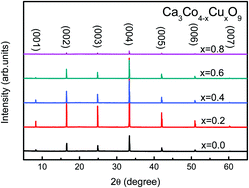Enhanced electronic correlation and thermoelectric response by Cu-doping in Ca3Co4O9 single crystals
Abstract
The structure, anisotropic magnetic, electrical and thermal transport properties for single crystals of Ca3Co4−xCuxO9 (x = 0, 0.2, 0.4, 0.6 and 0.8) have been investigated systematically. The Cu-doping with x = 0.2 at Co-site is sufficient to drive the low-temperature spin-glass state in the Ca3Co4O9 system. The value of resistivity along ab-plane decreases monotonously with increasing x in the whole temperature range studied, and around room temperature, the in-plane resistivity of Ca3Co3.2Cu0.8O9 is about 71% smaller than that of the undoped sample. The temperature region where the Fermi-liquid transport mechanism dominates becomes remarkably narrowed due to the Cu-doping while the electronic correlation in the system is enhanced. With further addition of Cu in the Ca3Co4O9 system, the in-plane thermopower (Sab) increases slowly and the room-temperature Sab for Ca3Co3.2Cu0.8O9 is about 17% larger than that of the undoped sample. As a result, the power factor along the ab-plane is enhanced by about 3.8 times compared to the undoped sample. The results are suggested to originate from the variations of carrier concentration and electronic correlation in this system via the different Cu-doping states: Cu3+/Cu2+ (Cu3+ major) into the CoO2 layer for x ≤ 0.4, while Cu2+/Cu3+ (Cu2+ major) into the Ca2CoO3 layers for x > 0.4.


 Please wait while we load your content...
Please wait while we load your content...